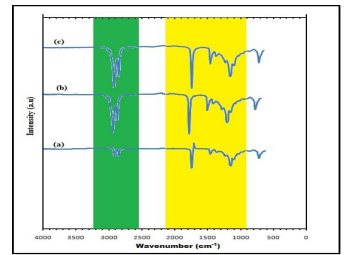Preparation of Neem Oil and Acrylonitrile Based Copolymeric Materials as a Potential Bio-Based Additives and Its Effect on Pour Point Depressant of a Lube Oil
Keywords:
Neem oil, Antioxidant, Copolymeric materials, lube oil, pour point depressant, Biodegradability (green additives)Abstract
In other to minimize environmental pollution, green additives prepared from bio-source with low cost and multi-functional applications have driven considerable attention in the field of lube oil industry. In this research, Neem oil was extracted using n-hexane as a solvent and some amount of Neem oil has mixed with turmeric rhizome (Antioxidant) to ascertain its oxidative stability and it was examined by FT-IR analysis. Copolymer derived from Neem oil and acrylonitrile was prepared by direct polymerization through the double bond of the fatty acid chain in the present of free radical initiator led to the formation of environmentally friendly Copolymeric based additives. The prepared Copolymer have been characterized by routine spectroscopic analysis. The rheological behavior and performance evaluation of the lube oil were examined in different concentration of additive Viz. 1% 2% 3% (w/v). However, the green additive act as good pour points depressant improver to the lube oil. The values of pour point for the lube oil blended with different prepared Copolymeric additives ranging from (9 to -110C). Thus, bio-based oil derived additive can be considered as a good alternative to be used in lube oil formulation.
References
Mohammed, A., Dhedan, R. M., Mahmood, W. A., & Musa, A."Copolymers of Castor and Corn Oils with Lauryl Methacrylate as Green Lubricating Additives. Egyptian Journal of Chemistry, 64(8) pp. 4271-4276, 2021.
Kumar, D., S. “Modification of lube oil properties by addition of organic polymeric additives”. North Bengal university, India- 3(6) pp. 734013, 2018
Musak, Y., Kovalenko, T., Serdiuk, V., Kravets, T., &Martynyak-Andrushko, M. “Obtaining of polymethacrylate additives and study in operational properties of an alloyed industrial Oil”. Eastern-European Journal of Enterprise Tecnologies, pp. 9-15, 2016.
Saha, D.K., &Ghosh,P. “Synthesis, characterization and performance evaluation of Long chain methacrylate-octene copolymer for Lubricant formulation”. Journal Macromolecular Science, Part A, 56(11) pp. 1050-1059, 2019.
Karmakar. G., Dey, K., Ghosh, P., Sharma, B.K., &Erhan,S Z. “A short review on polymeric biomaterials as additives for lubricants”. Polymers, pp. 1333, 2021.
Agarwal, p., S., Portal, J., Singh, R. K., &Portal, S. K. “Evaluation of renewable feedstock-derived Copolymer of stearyl methacrylate-co-triglyceride as multifunctional green additives in lubricant”. Polymer Bulletin, pp. 1-16, 2021
Liao, Y. H., Su, Y. L., & Chen, Y. C. “The Influence of Neem Oil and Its Glyceride on the Structure and Characterization of Castor Oil-Based Polyurethane Foam. Polymers”. Vol 13(12) Pp.103-106,2020.
Bhan, U., Singh, D., & Ranganathan, A. “Effect of different loads on the friction and wear characteristics of material lubricated with neem oil”. Materials Today: Proceedings vol. 46 pp. 10113-10116, 2021
Ghosh, P., Hoque, M., Roy, D. “Castor oil and acrylate-based copolymer as a green additive for lubricating oil”. Polymer pp. 734-737, 2020
Quinchia, L. A., Delgado, M. A., Valencia, C., Franco, J. M., & Gallegos, C. “Natural and synthetic antioxidant additives for improving the performance of new biolubricant formulations”. Journal of agricultural and food chemistry, 59(24) pp. 12917-12924, 2011
Nandiyanto, A. B. D., Oktiani, R., & Ragadhita, R. “How to read and interpret FTIR spectroscope of organic material”. Indonesian Journal of Science and Technology, 4(1) pp. 97-118, 2019
Mohammed, A. H., Mahmood, T. A., Yousif, S. A., & Musa, A. “Sunflower and Linseed Oils with Decyl Methacrylate Based Copolymers as Green Lubricating Additives”. In Materials Science Forum (Vol. 1045), pp. 109–116, 2021.

Downloads
Published
How to Cite
Issue
Section
License

This work is licensed under a Creative Commons Attribution 4.0 International License.
Authors contributing to this journal agree to publish their articles under the Creative Commons Attribution 4.0 International License, allowing third parties to share their work (copy, distribute, transmit) and to adapt it, under the condition that the authors are given credit and that in the event of reuse or distribution, the terms of this license are made clear.





